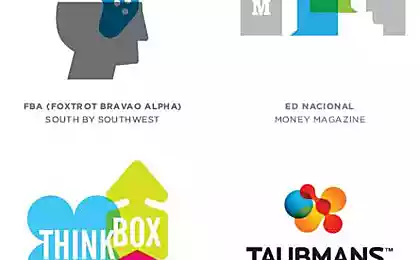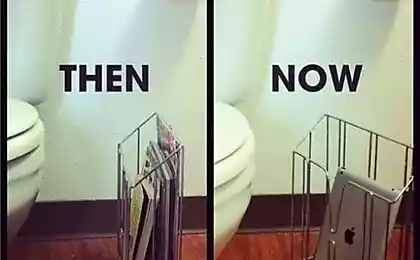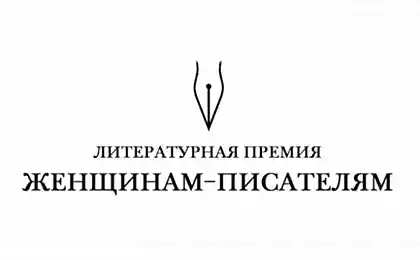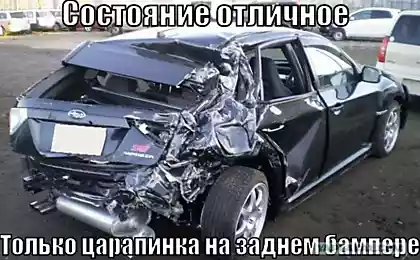1011
The evolution of automobile logos (18 pics + text)
It is interesting to watch grow and develop cars for hundreds of years. Here are some of the history of the automobile companies and their logos. Now, standing in a traffic jam, and considering the adjacent car, you'll know that the Volkswagen logo is associated with Hitler and swastika, and the Audi - a syndicate of four different car manufacturers.
1. At the beginning of the 30s in the design office of Ferdinand Porsche (Ferdinand Porsche) in Stuttgart have developed several prototypes zadnemotornyh small cars with 4-cylinder boxer engine companies "Tsyundapp» (Zundapp) and NSO (NSU). In 1934, Adolf Hitler commissioned Porsche to mass-produce such cars. The leader of the Nazis decided to give the German people and the cheap mass model, which he called "Volkswagen» (Volkswagen, abbreviated VW), ie "People's car".

2. Alfa Romeo appeared in 1910 as ALFA (Anonima Lombarda Fabbrica di Automobili), t. E. "Lombard Joint Stock Company for the production of cars." At the head of the company stood Ugo Stella, but in 1915 the firm moves to Nicola Romeo, who after the war resumes production of cars based on the new 4-cylinder engine. Romeo gave the company its harmonious and easy to remember name. Symbols logo depicted on the emblem of the city of Milan and related to the Crusaders, which is why the cross is used. Figure-eating snake, or a child or a Saracen, depending on who tells you about it.
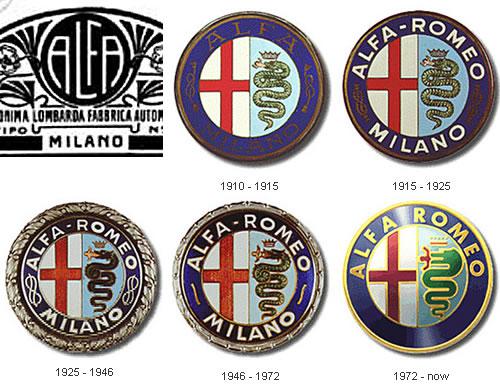
3. "ASTON MARTIN» (Aston Martin Lagonda Limited) - a British company - a manufacturer of luxury cars. The history of the company "Aston Martin" began in 1914 when two entrepreneurs and avid motorist - Robert Bamford and Lionel Martin - opened in London's Kensington joint venture "Bamford and Martin Limited" for the production of cars. 4. The company Audi (Audi) was formed in 1910 by a court decision. Hear the case on the accusation August Horch his former colleagues from the same company Horch. As a result of disagreements wayward Horch was forced out of his own company, which was founded in Zwickau in 1899. Later he creates in the same city, a new company and assign it its name. Not long existed in a small town of two companies to produce cars with the same name: the second by the court was given a new name Audi, which in Latin - the same thing that Horch in German - "to listen." In 1932, four German company DKW, Audi, Horch and Wanderer merged into automotive group Auto Union. Logo Audi (the famous four rings) symbolizes the union of the four previously independent automobile manufacturers, known as the «Auto Union»: Audi, DKW, Horch and Wanderer. Cars these producers, along with their own logo bore a sign in the form of a group of four intertwined rings, symbolizing the unbreakable unity of the four founder companies.
5. In 1913, on the northern outskirts of Munich, Karl Rapp and Gustav Otto, the son of the inventor of the internal combustion engine Nikolaus August Otto, create two small aircraft engine company. The outbreak of World War I immediately brought numerous orders for aircraft engines. Rapp and Otto decided to unite in a single aircraft engine plant. Thus arises the plant in Munich aircraft engines, July 20, 1917 which is registered under the name Bayerische Motoren Werke («Bavarian Motor Works») - BMW. This date is considered the founding year of BMW, and Karl Rapp and Gustav Otto by its creators. After the First World War the firm was on the verge of collapse, t. To. The Treaty of Versailles prohibited the Germans produce engines for aircraft, namely the engines at the time were the only production BMW. But enterprising Karl Rapp and Gustav Otto find a way out - the plant have shifted to production of first motorcycle engines and then motorcycles and themselves. The first machine ("Wartburg"), was published in 1898 after the establishment by a number of 3- and 4-wheeled prototype. The first emblem adopted in 1917, was portrayed by the rotating propeller. However, the emblem seemed too complicated and shallow, and by 1920 the propeller was heavily stylized. The circle of the propeller were divided into four quarters, silver-white sector in the black steel bezel with alternating sky-blue.

6. Cadillac - English pronunciation of the names of the Frenchman Antoine de la Mothe Kadiyyaka (Antoine de la Mothe Cadillac), who founded Detroit in 1701. Since 1909, "Cadillac" has moved to 4-cylinder engines and one of the first joined the group "GM» (General Motors). In the first years of the "Cadillac" in the new group was assigned the role of the manufacturer's most expensive and luxury cars. 7. Abbreviation Fiat stands for Fabrica Italiana Automobili Torino, but in the Italian language, there is also the word fiat, meaning "decree", this concept is no less characterized activities of the group. After all, a company founded by Giovanni Agnelli, proved commercially very successful, and by the end of the twentieth century, the auto industry has enslaved the Apennine peninsula. The Fiat empire includes names such as Alfa Romeo, Lancia, Abarth, Ferrari and Maserati, the names of the places of worship not only for Italy but also for the rest of the world. Besides cars practically all existing types, Fiat produces agricultural equipment, including tractors, marine engines, as well as deals with aerospace technology. A story began colossus italyanskoy industry in 1899, with machines manufactured under license from Renault.
First Fiat used the emblem consisting of a five-rays on the model Uno in 1982, it happened after one day the chief designer of the Fiat Mario Maioli driving at night past the plant Mirafiori after switching off the light, I saw on the roof of the factory huge logo FIAT against the darkening sky . He quickly made a sketch - five-rays depicted gaps that were visible between the letters. Like the Maserati cars Alfa, Maserati symbol - a consequence of pride in their city - the trident is the traditional emblem of Bologna, where these cars were produced. 8. According to the legend, the idea of creating a vehicle that does not require the use of animal power for the first time came in 1872, the son of an Irish immigrant Henry Ford (Henry Ford), when working on his father's farm, he fell from his horse and hurt yourself.
June 16, 1903, Henry Ford with his 11th friends have gathered an impressive amount of time for 28,000 dollars and have applied to the organization of a new industrial plant in the US state of Michigan. Thus came the famous automobile company «Ford Motor Company».
The right hand of Mr. Harold Wills, Ford earned money in their youth that printed business cards, so when Henry began in 1903 to look for the logo, he wiped the dust off his old John Bull printing apparatus. The imprint was still on his own business cards. The oval appeared in 1912, and the blue color was added in 1927 to the model of the car the Mazda 9, like all Japanese, has a fairly original story, which begins with the production of construction materials from balsa wood in 1920. In subsequent years, Mazda began producing machinery, motorcycles, the trucks, and then, and cars, making his skate rotary engine.
Logo Mazda - is not just a stylized tulip. It was designed by Ray Yoshimaroy, internationally renowned corporate image-maker, V represents outstretched wings, and - according to Mazda - creativity, a sense of mission, tenderness and flexibility - all combined in the Mazda. 10. The history of the Mercedes belongs to the 70s of the last century-pose. Nikolaus Otto created the first German petrol engine. On the gasoline internal combustion engine drew attention Gottlieb Daimler, the technical director of the factory gas engines «Deutz».
In 1883-1884, the postroina and tested a series of small size and relatively powerful for the time internal combustion engines;
in 1885, it was designed and assembled the first motorcycle equipped with a single-cylinder four-stroke engine, and then,
in 1886 - the famous "motor carriage" Daimler with the engine mounted on the cab, which is considered the world's first real car, get practical application.
In 1899, Daimler Providence connects with another fan of gasoline engines. In that year, in the Austro-Hungarian consulate in Nice, he arrived with his family a new consul - Czech by nationality, Emil Jellinek, a man boundless energy and slightly eccentric. Seeing one of the vehicles of Daimler, the Consul very interested in it and wanted to experience what a car. Learning who manufactures these machines, he went to the factory and quickly found a mutual understanding with the leadership of the firm. Since then, the interests of Daimler and Jelinek closely intertwined.
He offered to buy the company a large shipment of 36 cars, but on certain conditions. First of all, knowing that in a mountain race, killing one of the drivers, Jelinek has demanded some changes in body structure and chassis to lower the center of gravity, to install a new engine and achieve the optimum ratio of vehicle weight and engine power. Then an acquaintance with William Meybahom who designed and made the necessary design changes to the new model. Jelinek also demanded to leave him the right to give the name of the future of the automobile. Daimler could not immediately agree with this, but then gave up yet - it's going to be a very reasonable deal. The car, designed Meybahom, weighed less than its predecessor, was lower and longer, and could reach a speed of 80 km / h. Jelinek, in turn, sold them won the right to fair trading and named a new car after his eldest daughter - "Mercedes", which means in Spanish charity.
Mercedes three-pointed star symbolizes the power over land, sea and air.

11. When in the distant 1870s, Japan emerged from a period of more than 300 years of feudal isolation, a young entrepreneur Yataro Iwasaki (Yataro Iwasaki) founded a small shipping company «Tsukomo Shokai» (Tsukomo shock). In 1875, after several changes of names it was called Mitsubishi Mail Steamship Company (Postal shipping company and Mitsubishi) - appeared as the father of all modern companies Mitsubishi.
The desire to introduce new ideas began in 1917 with the historic car Model-A (Model-A), which was produced for 4 years and was so highly praised by the society that became exhibits Industry of Japan in 1922 "Model-A" has helped Mitsubishi establish one of the major Japanese automakers.
The world-famous brand originated from the merger of the Mitsubishi family coats of arms of the founders. From the family of the cross Iwasaki (three sheets of water chestnut) and cross home Yamanouchi (three oak leaf) occurred logo Mitsubishi - "three diamond" (translated from the Japanese. "Mitsu" - 3 "Bisi" - diamond)

12. In 1989, the company "Peugeot" celebrated its centenary as an automotive company. But full of adventure "The history of Peugeot" began much earlier: its first period was an era of pioneers, which is about 1810 was marked by the opening of the first metal-working factory, followed by the production of tools and astounding success with bicycles.
Peugeot brothers come from an ancient family, which dates back to the 15th century. The brothers lived near Montbeliard in the French department of Oak. In 1810, these young people come to turn his mill into a factory for metal processing.
The first character of the trade mark of "Peugeot" was developed by Justine Belezerom, goldsmith and engraver in the vicinity of Montbeliard (Vandonkura). As a result, the company has adopted three draft emblems with which it would be possible to distinguish three product names:
1. Lion boom or without boom - for the best products.
2. Crescent - for products of the second category.
3. Hand - products of the third category.
In 1932, the lion has been modified to comply with the advertising and exhibition purposes at the time. 13. The company's history began with the first car assembled by Louis Renault in 1898, light vuatyuretki (from the French. Voiturette - povozochka, truck) with a capacity of only 0, 75 hp Next machine, known as a "model A» with the engine "De Dion-bud" with a capacity of 1, 75 hp on the tubular frame it was very successful, and Louis with his older brothers organized a company «Brothers of Renault» (Renault Freres), already in 1899 made and sold 15 "Models A». 14. The history of "Saab" dates back to 1937, and not with the automobile production, as it usually happens with brands born before World War II. Young company «Svenska Aeroplan AktieBolaget» («SAAB») specializing in the production of fighters and bombers for the Swedish Air Force.
"Winged past," the company has played a decisive role in the formation of the logo, but few people know that the very first mascot, "Saab" - "Tre krunor" (Three Crowns), which can be seen today in the form of the current world champions in ice hockey.
The first prototype of the car appeared at the end of 1946 - it was a prototype model of "92", production of which began in 1949. Then for the first time it has been completely redesigned company logo. Crown was replaced by a stylized aircraft - deployed on the wings (front view) sported the words "Saab". Logo periodically revised to 63 th year, the silhouette of an airplane separated from the name. Up to 1965 on the hood present a distinct image of the winged - twin-engine aircraft with propellers.
May 19, 1965 th company was renamed «Saab Aktiebolag», together with the name and logo has been updated: now the name of four letters visually zakomponovano in the square, and the wings are moved to the side, turned in chrome decor element falshradiatornoy lattice. Then, as a result of the merger of «Saab Aktiebolag» manufacturer of trucks «Aktiebolag Scania-Vabis» («Scania-Vabis') in 1969 to the year, was created« Saab-Scania », and here the Swedes have decided to return to the previous version of the logo - on the hood again shone silhouettes of twin-engine aircraft. In the second half of the 70s the proportion of inscriptions become restrained and less pretentious - a tribute time.
And finally, in the mid-80's was born the image of the Griffin, symbolizing the products of the company «Saab-Scania» to this day.

15. Buick Motor Company was founded in 1903 by David Dunbar Buick, the inventor of the Scottish-American. The company, which later became the largest auto company, General Motors.
Source:
1. At the beginning of the 30s in the design office of Ferdinand Porsche (Ferdinand Porsche) in Stuttgart have developed several prototypes zadnemotornyh small cars with 4-cylinder boxer engine companies "Tsyundapp» (Zundapp) and NSO (NSU). In 1934, Adolf Hitler commissioned Porsche to mass-produce such cars. The leader of the Nazis decided to give the German people and the cheap mass model, which he called "Volkswagen» (Volkswagen, abbreviated VW), ie "People's car".

2. Alfa Romeo appeared in 1910 as ALFA (Anonima Lombarda Fabbrica di Automobili), t. E. "Lombard Joint Stock Company for the production of cars." At the head of the company stood Ugo Stella, but in 1915 the firm moves to Nicola Romeo, who after the war resumes production of cars based on the new 4-cylinder engine. Romeo gave the company its harmonious and easy to remember name. Symbols logo depicted on the emblem of the city of Milan and related to the Crusaders, which is why the cross is used. Figure-eating snake, or a child or a Saracen, depending on who tells you about it.

3. "ASTON MARTIN» (Aston Martin Lagonda Limited) - a British company - a manufacturer of luxury cars. The history of the company "Aston Martin" began in 1914 when two entrepreneurs and avid motorist - Robert Bamford and Lionel Martin - opened in London's Kensington joint venture "Bamford and Martin Limited" for the production of cars. 4. The company Audi (Audi) was formed in 1910 by a court decision. Hear the case on the accusation August Horch his former colleagues from the same company Horch. As a result of disagreements wayward Horch was forced out of his own company, which was founded in Zwickau in 1899. Later he creates in the same city, a new company and assign it its name. Not long existed in a small town of two companies to produce cars with the same name: the second by the court was given a new name Audi, which in Latin - the same thing that Horch in German - "to listen." In 1932, four German company DKW, Audi, Horch and Wanderer merged into automotive group Auto Union. Logo Audi (the famous four rings) symbolizes the union of the four previously independent automobile manufacturers, known as the «Auto Union»: Audi, DKW, Horch and Wanderer. Cars these producers, along with their own logo bore a sign in the form of a group of four intertwined rings, symbolizing the unbreakable unity of the four founder companies.
5. In 1913, on the northern outskirts of Munich, Karl Rapp and Gustav Otto, the son of the inventor of the internal combustion engine Nikolaus August Otto, create two small aircraft engine company. The outbreak of World War I immediately brought numerous orders for aircraft engines. Rapp and Otto decided to unite in a single aircraft engine plant. Thus arises the plant in Munich aircraft engines, July 20, 1917 which is registered under the name Bayerische Motoren Werke («Bavarian Motor Works») - BMW. This date is considered the founding year of BMW, and Karl Rapp and Gustav Otto by its creators. After the First World War the firm was on the verge of collapse, t. To. The Treaty of Versailles prohibited the Germans produce engines for aircraft, namely the engines at the time were the only production BMW. But enterprising Karl Rapp and Gustav Otto find a way out - the plant have shifted to production of first motorcycle engines and then motorcycles and themselves. The first machine ("Wartburg"), was published in 1898 after the establishment by a number of 3- and 4-wheeled prototype. The first emblem adopted in 1917, was portrayed by the rotating propeller. However, the emblem seemed too complicated and shallow, and by 1920 the propeller was heavily stylized. The circle of the propeller were divided into four quarters, silver-white sector in the black steel bezel with alternating sky-blue.

6. Cadillac - English pronunciation of the names of the Frenchman Antoine de la Mothe Kadiyyaka (Antoine de la Mothe Cadillac), who founded Detroit in 1701. Since 1909, "Cadillac" has moved to 4-cylinder engines and one of the first joined the group "GM» (General Motors). In the first years of the "Cadillac" in the new group was assigned the role of the manufacturer's most expensive and luxury cars. 7. Abbreviation Fiat stands for Fabrica Italiana Automobili Torino, but in the Italian language, there is also the word fiat, meaning "decree", this concept is no less characterized activities of the group. After all, a company founded by Giovanni Agnelli, proved commercially very successful, and by the end of the twentieth century, the auto industry has enslaved the Apennine peninsula. The Fiat empire includes names such as Alfa Romeo, Lancia, Abarth, Ferrari and Maserati, the names of the places of worship not only for Italy but also for the rest of the world. Besides cars practically all existing types, Fiat produces agricultural equipment, including tractors, marine engines, as well as deals with aerospace technology. A story began colossus italyanskoy industry in 1899, with machines manufactured under license from Renault.
First Fiat used the emblem consisting of a five-rays on the model Uno in 1982, it happened after one day the chief designer of the Fiat Mario Maioli driving at night past the plant Mirafiori after switching off the light, I saw on the roof of the factory huge logo FIAT against the darkening sky . He quickly made a sketch - five-rays depicted gaps that were visible between the letters. Like the Maserati cars Alfa, Maserati symbol - a consequence of pride in their city - the trident is the traditional emblem of Bologna, where these cars were produced. 8. According to the legend, the idea of creating a vehicle that does not require the use of animal power for the first time came in 1872, the son of an Irish immigrant Henry Ford (Henry Ford), when working on his father's farm, he fell from his horse and hurt yourself.
June 16, 1903, Henry Ford with his 11th friends have gathered an impressive amount of time for 28,000 dollars and have applied to the organization of a new industrial plant in the US state of Michigan. Thus came the famous automobile company «Ford Motor Company».
The right hand of Mr. Harold Wills, Ford earned money in their youth that printed business cards, so when Henry began in 1903 to look for the logo, he wiped the dust off his old John Bull printing apparatus. The imprint was still on his own business cards. The oval appeared in 1912, and the blue color was added in 1927 to the model of the car the Mazda 9, like all Japanese, has a fairly original story, which begins with the production of construction materials from balsa wood in 1920. In subsequent years, Mazda began producing machinery, motorcycles, the trucks, and then, and cars, making his skate rotary engine.
Logo Mazda - is not just a stylized tulip. It was designed by Ray Yoshimaroy, internationally renowned corporate image-maker, V represents outstretched wings, and - according to Mazda - creativity, a sense of mission, tenderness and flexibility - all combined in the Mazda. 10. The history of the Mercedes belongs to the 70s of the last century-pose. Nikolaus Otto created the first German petrol engine. On the gasoline internal combustion engine drew attention Gottlieb Daimler, the technical director of the factory gas engines «Deutz».
In 1883-1884, the postroina and tested a series of small size and relatively powerful for the time internal combustion engines;
in 1885, it was designed and assembled the first motorcycle equipped with a single-cylinder four-stroke engine, and then,
in 1886 - the famous "motor carriage" Daimler with the engine mounted on the cab, which is considered the world's first real car, get practical application.
In 1899, Daimler Providence connects with another fan of gasoline engines. In that year, in the Austro-Hungarian consulate in Nice, he arrived with his family a new consul - Czech by nationality, Emil Jellinek, a man boundless energy and slightly eccentric. Seeing one of the vehicles of Daimler, the Consul very interested in it and wanted to experience what a car. Learning who manufactures these machines, he went to the factory and quickly found a mutual understanding with the leadership of the firm. Since then, the interests of Daimler and Jelinek closely intertwined.
He offered to buy the company a large shipment of 36 cars, but on certain conditions. First of all, knowing that in a mountain race, killing one of the drivers, Jelinek has demanded some changes in body structure and chassis to lower the center of gravity, to install a new engine and achieve the optimum ratio of vehicle weight and engine power. Then an acquaintance with William Meybahom who designed and made the necessary design changes to the new model. Jelinek also demanded to leave him the right to give the name of the future of the automobile. Daimler could not immediately agree with this, but then gave up yet - it's going to be a very reasonable deal. The car, designed Meybahom, weighed less than its predecessor, was lower and longer, and could reach a speed of 80 km / h. Jelinek, in turn, sold them won the right to fair trading and named a new car after his eldest daughter - "Mercedes", which means in Spanish charity.
Mercedes three-pointed star symbolizes the power over land, sea and air.

11. When in the distant 1870s, Japan emerged from a period of more than 300 years of feudal isolation, a young entrepreneur Yataro Iwasaki (Yataro Iwasaki) founded a small shipping company «Tsukomo Shokai» (Tsukomo shock). In 1875, after several changes of names it was called Mitsubishi Mail Steamship Company (Postal shipping company and Mitsubishi) - appeared as the father of all modern companies Mitsubishi.
The desire to introduce new ideas began in 1917 with the historic car Model-A (Model-A), which was produced for 4 years and was so highly praised by the society that became exhibits Industry of Japan in 1922 "Model-A" has helped Mitsubishi establish one of the major Japanese automakers.
The world-famous brand originated from the merger of the Mitsubishi family coats of arms of the founders. From the family of the cross Iwasaki (three sheets of water chestnut) and cross home Yamanouchi (three oak leaf) occurred logo Mitsubishi - "three diamond" (translated from the Japanese. "Mitsu" - 3 "Bisi" - diamond)

12. In 1989, the company "Peugeot" celebrated its centenary as an automotive company. But full of adventure "The history of Peugeot" began much earlier: its first period was an era of pioneers, which is about 1810 was marked by the opening of the first metal-working factory, followed by the production of tools and astounding success with bicycles.
Peugeot brothers come from an ancient family, which dates back to the 15th century. The brothers lived near Montbeliard in the French department of Oak. In 1810, these young people come to turn his mill into a factory for metal processing.
The first character of the trade mark of "Peugeot" was developed by Justine Belezerom, goldsmith and engraver in the vicinity of Montbeliard (Vandonkura). As a result, the company has adopted three draft emblems with which it would be possible to distinguish three product names:
1. Lion boom or without boom - for the best products.
2. Crescent - for products of the second category.
3. Hand - products of the third category.
In 1932, the lion has been modified to comply with the advertising and exhibition purposes at the time. 13. The company's history began with the first car assembled by Louis Renault in 1898, light vuatyuretki (from the French. Voiturette - povozochka, truck) with a capacity of only 0, 75 hp Next machine, known as a "model A» with the engine "De Dion-bud" with a capacity of 1, 75 hp on the tubular frame it was very successful, and Louis with his older brothers organized a company «Brothers of Renault» (Renault Freres), already in 1899 made and sold 15 "Models A». 14. The history of "Saab" dates back to 1937, and not with the automobile production, as it usually happens with brands born before World War II. Young company «Svenska Aeroplan AktieBolaget» («SAAB») specializing in the production of fighters and bombers for the Swedish Air Force.
"Winged past," the company has played a decisive role in the formation of the logo, but few people know that the very first mascot, "Saab" - "Tre krunor" (Three Crowns), which can be seen today in the form of the current world champions in ice hockey.
The first prototype of the car appeared at the end of 1946 - it was a prototype model of "92", production of which began in 1949. Then for the first time it has been completely redesigned company logo. Crown was replaced by a stylized aircraft - deployed on the wings (front view) sported the words "Saab". Logo periodically revised to 63 th year, the silhouette of an airplane separated from the name. Up to 1965 on the hood present a distinct image of the winged - twin-engine aircraft with propellers.
May 19, 1965 th company was renamed «Saab Aktiebolag», together with the name and logo has been updated: now the name of four letters visually zakomponovano in the square, and the wings are moved to the side, turned in chrome decor element falshradiatornoy lattice. Then, as a result of the merger of «Saab Aktiebolag» manufacturer of trucks «Aktiebolag Scania-Vabis» («Scania-Vabis') in 1969 to the year, was created« Saab-Scania », and here the Swedes have decided to return to the previous version of the logo - on the hood again shone silhouettes of twin-engine aircraft. In the second half of the 70s the proportion of inscriptions become restrained and less pretentious - a tribute time.
And finally, in the mid-80's was born the image of the Griffin, symbolizing the products of the company «Saab-Scania» to this day.

15. Buick Motor Company was founded in 1903 by David Dunbar Buick, the inventor of the Scottish-American. The company, which later became the largest auto company, General Motors.
Source:
